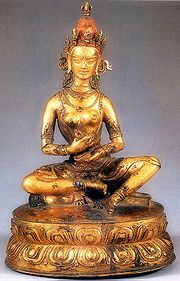Nairatmya

Nairatmya, Central Tibet, sixteenth century. Gilt copper inset with turquoise, painted with red pigment, H9.25 in. (23.5 cm). Los Angeles County Museum of Art, From the Nasli and Alice Heeramaneck Collection, purchase, M.70.1.4. Nairatmya represented as a seated yogini, her face ablaze with all-seeing wisdom.
Nairātmyā or Dagmema (Wylie: bdag med ma) is a in Buddhism, the consort of Hevajra in the Hevajra-tantra. The name means "she who has no self (ātman)". Nair-ātmyā is the feminine form of nairātmya which comes from nirātman (the Sanskrit negative particle "niḥ" combined with the masculine noun for self-"ātman"); nairātmya means "of nirātman", and in the feminine form, nairātmyā, "she who has no self". Nair-ātmyā, the no-self female, that is, she who has no self. She is an embodiment of the Buddhist philosophical concept of anātman (anatta in Pāli).
References[]
See also[]
- Nairatmya - Concept in Buddhism
- Sitatapatra
- Narodakini
- Saraswati
- Queen Maya
- Hariti
- Yakshini
- Prithvi
- Vajrayogini
- Tara (Buddhism)
Categories:
- Buddhas
- Dakinis
- Female buddhas and supernatural beings